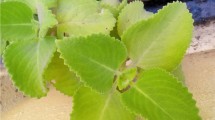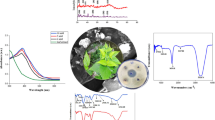Abstract
The present investigation focused on the biosynthesis of copper oxide nanoparticles (CuONPs) using Halymenia dilatata seaweed aqueous extract. The biosynthesized CuONPs were successfully characterized using UV, FTIR, XRD, SEM, EDAX, HRTEM, and zeta potential analysis. The ultraviolet visible spectrum reflects maximum absorbance in the scale of 270 nm. The biosynthesized CuONPs had crystalline nature and were investigated using XRD. The FT-IR spectrum of CuONPs showed flavonoids and phenolic compounds could reduce the Cu2+ ions to CuONPs. SEM results indicated the nanoparticles were spherically shaped and 60 nm in size. The antimicrobial activity of H. dilatata mediated CuONPs was tested against six human pathogenic bacteria, and the highest growth inhibition was observed in B. subtillis (7.5 ± 0.4), S. aureus (6.8 ± 0.1), and K. pneumoniae (5.4 ± 0.8). The anticancer activity of HeLa cell line indicates a significant outcome with IC50 value (147.51 lg/ml) after 48 h treatment.
Graphical Abstract










Similar content being viewed by others
Data availability
The date used to support the findings of this study are included within the manuscript.
References
Rajeshkumar S, Kannan C, Annadurai G (2012) Synthesis and characterization of antimicrobial silver nanoparticles using marine brown seaweed Padina tetrastromatica. Drug Invent Today 4:511–513
Roy A, Bulut O, Some S, Mandal AK, Yilmaz MD (2019) Green synthesis of silver nanoparticles: biomolecule-nanoparticle organizations targeting antimicrobial activity. RSC Adv 9:2673–2702. https://doi.org/10.1039/C8RA08982E
Phongtongpasuk S, Poadang S, Yongvanich N (2016) Environmental-friendly method for synthesis of silver nanoparticles from dragon fruit peel extract and their antibacterial activities. Energy Procedi 89:239–247. https://doi.org/10.1016/j.egypro.2016.05.031
Latha N, Gowri M (2014) Biosynthesis and characterisation of Fe3O4 nanoparticles using Caricaya papaya leaves extract. Int J Sci Res 3:1551–1556
Marchiol L, Mattiello A, Pošćić F, Giordano C, Musetti R (2014) In vivo synthesis of nanomaterials in plants: location of silver nanoparticles and plant metabolism. Nanoscale Res Lett 9:1–11. https://doi.org/10.1186/1556-276X-9-101
Siddiqi KS, Husen A (2016) Fabrication of metal nanoparticles from fungi and metal salts: scope and application. Nanoscale Res Lett 11:1–15. https://doi.org/10.1186/s11671-016-1311-2
Yasmin A, Ramesh K, Rajeshkumar S (2014) Optimization and stabilization of gold nanoparticles by using herbal plant extract with microwave heating. Nano Converg 1:1–7. https://doi.org/10.1186/s40580-014-0012-8
Banerjee P, Satapathy M, Mukhopahayay A, Das P (2014) Leaf extract mediated green synthesis of silver nanoparticles from widely available Indian plants: synthesis, characterization, antimicrobial property and toxicity analysis. Bioresour Bioprocess 1:1–10. https://doi.org/10.1186/s40643-014-0003-y
Betancourt-Galindo R, Reyes-Rodriguez PY, Puente-Urbina BA, Avila-Orta CA, Rodríguez-Fernández OS, Cadenas-Pliego G, García-Cerda LA, Synthesis of copper nanoparticles by thermal decomposition and their antimicrobial properties. J Nanomater https://doi.org/10.1155/2014/980545
Din MI, Rehan R (2017) Synthesis, characterization, and applications of copper nanoparticles. Anal Lett 50:50–62. https://doi.org/10.1080/00032719.2016.1172081
Granata G, Yamaoka T, Pagnanelli F, Fuwa A (2016) Study of the synthesis of copper nanoparticles: the role of capping and kinetic towards control of particle size and stability. J Nanopart Res 18:1–12. https://doi.org/10.1007/s11051-016-3438-6
Shubhashree KR, Reddy R, Gangula AK, Nagananda GS, Badiya PK, Ramamurthy SS, Reddy N (2022) Green synthesis of copper nanoparticles using aqueous extracts from Hyptis suaveolens (L.). Mater Chem Phys 280:125795. https://doi.org/10.1016/j.matchemphys.2022.125795
Adewale OB, Egbeyemi KA, Onwuelu JO, Potts-Johnson SS, Anadozie SO, Fadaka AO, Onasanya A (2020) Biological synthesis of gold and silver nanoparticles using leaf extracts of Crassocephalum rubens and their comparative in vitro antioxidant activities. Heliyon 6:e05501. https://doi.org/10.1016/j.heliyon.2020.e05501
Williams DN, Ehrman SH, Pulliam Holoman TR (2006) Evaluation of the microbial growth response to inorganic nanoparticles. J Nanobiotechnol 4:3. https://doi.org/10.1186/1477-3155-4-3
Sathiyavimal S, Vasantharaj S, Bharathi D, Saravanan M, Manikandan E, Kumar SS, Pugazhendhi A (2018) Biogenesis of copper oxide nanoparticles (CuONPs) using Sida acuta and their incorporation over cotton fabrics to prevent the pathogenicity of Gram negative and Gram positive bacteria. J Photochem Photobiol B: Biol 188:126–134. https://doi.org/10.1016/j.jphotobiol.2018.09.014
Vaidehi D, Bhuvaneshwari V, Bharathi D, Sheetal BP (2018) Antibacterial and photocatalytic activity of copper oxide nanoparticles synthesized using Solanum lycopersicum leaf extract. Mater Res Express 5:085403
Sharma A, Sharma S, Sharma K, Chetri SP, Vashishtha A, Singh P, Agrawal V (2016) Algae as crucial organisms in advancing nanotechnology: a systematic review. J Appl Phycol 28:1759–1774. https://doi.org/10.1007/s10811-015-0715-1
Ponnuchamy K, Jacob JA (2016) Metal nanoparticles from marine seaweeds–a review. Nanotech Revi 5:589–600. https://doi.org/10.1515/ntrev-2016-0010
Kannan RRR, Stirk WA, Van Staden J (2013) Synthesis of silver nanoparticles using the seaweed Codium capitatum PC Silva (Chlorophyceae). S Afr J Bot 86:1–4. https://doi.org/10.1016/j.sajb.2013.01.003
Rajeshkumar S, Malarkodi C, Gnanajobitha G, Paulkumar K, Vanaja M, Kannan C, Annadurai G (2013) Seaweed-mediated synthesis of gold nanoparticles using Turbinaria conoides and its characterization. J Nanostruct Chem 3:1–7. https://doi.org/10.1186/2193-8865-3-44
Priyadharshini RI, Prasannaraj G, Geetha N, Venkatachalam P (2014) Microwave-mediated extracellular synthesis of metallic silver and zinc oxide nanoparticles using macro-algae (Gracilaria edulis) extracts and its anticancer activity against human PC3 cell lines. Appl Biochem Biotechnol 174:2777–2790. https://doi.org/10.1007/s12010-014-1225-3
Sayadi MH, Salmani N, Heidari A, Rezaei MR (2018) Bio-synthesis of palladium nanoparticle using Spirulina platensis alga extract and its application as adsorbent. Surf Interfaces 10:136–143. https://doi.org/10.1016/j.surfin.2018.01.002
Ramaswamy SVP, Narendhran S, Sivaraj R (2016) Potentiating effect of ecofriendly synthesis of copper oxide nanoparticles using brown alga: antimicrobial and anticancer activities. Bull Mater Sci 39:361–364. https://doi.org/10.1007/s12034-016-1173-3
Sathiyaraj G, Vinosha M, Sangeetha D, Manikandakrishnan M, Palanisamy S, Sonaimuthu M, Prabhu NM (2021) Bio-directed synthesis of Pt-nanoparticles from aqueous extract of red algae Halymenia dilatata and their biomedical applications. Colloids Surf A Physicochem Eng Asp 618:126434. https://doi.org/10.1016/j.colsurfa.2021.126434
Yugandhar P, Vasavi T, Uma Maheswari Devi P, Savithramma N (2017) Bioinspired green synthesis of copper oxide nanoparticles from Syzygium alternifolium (Wt.) Walp: characterization and evaluation of its synergistic antimicrobial and anticancer activity Appl Nanosci 7:417–427. https://doi.org/10.1007/s13204-017-0584-9.
Fenoradosoa TA, Laroche C, Delattre C, Dulong V, Le Cerf D, Picton L, Michaud P (2012) Rheological behavior and non-enzymatic degradation of a sulfated galactan from Halymenia durvillei (Halymeniales, Rhodophyta). Appl Biochem Biotechnol 167:1303–1313. https://doi.org/10.1007/s12010-012-9605-z
Ahmed S, Saifullah Ahmad M, Swami BL, Ikram S (2016) Green synthesis of silver nanoparticles using Azadirachta indica aqueous leaf extract. J Radiat Res Appl Sci 9:1–7
Tchakam PD, Lunga PK, Kowa TK, Lonfouo AHN, Wabo HK, Tapondjou LA, Kuiate JR (2012) Antimicrobial and antioxidant activities of the extracts and compounds from the leaves of Psorospermum aurantiacum Engl. and Hypericum lanceolatum Lam. BMC complement Altern Medi 12:1–8. https://doi.org/10.1186/1472-6882-12-136
Mosdam TJJIM (1983) Rapid colorimetric assay for cellular growth and survival: application to proliferation and cytotoxic assay. J Immunol Methods 65:55–63
Monks A, Scudiero D, Skehan P, Shoemaker R, Paull K, Vistica D, Boyd M (1991) Feasibility of a high-flux anticancer drug screen using a diverse panel of cultured human tumor cell lines. J Nati Cancer Inst 83:757–766. https://doi.org/10.1093/jnci/83.11.757
Abboud Y, Eddahbi A, El Bouari A, Aitenneite H, Brouzi K, Mouslim J (2013) Microwave-assisted approach for rapid and green phytosynthesis of silver nanoparticles using aqueous onion (Allium cepa) extract and their antibacterial activity. J Nanostr Chem 3:1–7. https://doi.org/10.1186/2193-8865-3-84
Ruparelia JP, Chatterjee AK, Duttagupta SP, Mukherji S (2008) Strain specificity in antimicrobial activity of silver and copper nanoparticles. Acta Biomater 4:707–716. https://doi.org/10.1016/j.actbio.2007.11.006
Aboelfetoh EF, Ghobara E-S, MM, (2017) Eco-friendly synthesis of silver nanoparticles using green algae (Caulerpa serrulata): reaction optimization, catalytic and antibacterial activities. Environ Monit Assess 189:1–15. https://doi.org/10.1007/s10661-017-6033-0
Sharma B, Purkayastha DD, Hazra S, Gogoi L, Bhattacharjee CR, Ghosh NN, Rout J (2014) Biosynthesis of gold nanoparticles using a freshwater green alga, Prasiola crispa. Mater Lett 116:94–97. https://doi.org/10.1016/j.matlet.2013.10.107
Ramakrishna M, Rajesh Babu D, Gengan RM, Chandra S, Nageswara Rao G (2016) Green synthesis of gold nanoparticles using marine algae and evaluation of their catalytic activity. J Nanostr Chem 6:1–13. https://doi.org/10.1007/s40097-015-0173-y
Rani H, Singh SP, Yadav TP, Khan MS, Ansari MI, Singh AK (2020) In-vitro catalytic, antimicrobial and antioxidant activities of bioengineered copper quantum dots using Mangifera indica (L.) leaf extract. Mater Chem Phys 239:122052. https://doi.org/10.1016/j.matchemphys.2019.122052
Peternela J, Silva MF, Vieira MF, Bergamasco R, Vieira AMS (2017) Synthesis and impregnation of copper oxide nanoparticles on activated carbon through green synthesis for water pollutant removal. Mater Res 21https://doi.org/10.1590/1980-5373-MR-2016-0460
Rajeshkumar S, Nandhini NT, Manjunath K, Sivaperumal P, Prasad GK, Alotaibi SS, Roopan SM (2021) Environment friendly synthesis copper oxide nanoparticles and its antioxidant, antibacterial activities using Seaweed (Sargassum longifolium) extract. J Mol Struct 1242:130724. https://doi.org/10.1016/j.molstruc.2021.130724
Bhattacharya P, Swarnakar S, Ghosh S, Majumdar S, Banerjee S (2019) Disinfection of drinking water via algae mediated green synthesized copper oxide nanoparticles and its toxicity evaluation. J Environ Chem Eng 7:102867. https://doi.org/10.1016/j.jece.2018.102867
Kumari P, Panda PK, Jha E, Kumari K, Nisha K, Mallick MA, Verma SK (2017) Mechanistic insight to ROS and apoptosis regulated cytotoxicity inferred by green synthesized CuO nanoparticles from Calotropis gigantea to embryonic zebrafish. Sci Rep 7:1–17. https://doi.org/10.1038/s41598-017-16581-1
Wang L, Hu C, Shao L (2017) The antimicrobial activity of nanoparticles: present situation and prospects for the future. Int J Nanomed 12:1227. https://doi.org/10.2147/IJN.S121956
Weldegebrieal GK (2020) Photocatalytic and antibacterial activityof CuO nanoparticles biosynthesized using Verbascum thapsus leaves extract. Optik 204:164230. https://doi.org/10.1016/j.ijleo.2020.164230
Awwad A, Salem N, Amer M, Shammout M (2021) Adsorptive removal of Pb (II) and Cd (II) ions from aqueous solution onto modified Hiswa iron-kaolin clay: Equilibrium and thermodynamic aspects. AM Awwad, NM Salem, MW Amer and MW Shammout. Adsorptive removal of Pb (II) and Cd (II) ions from aqueous solution onto modified Hiswa iron-kaolin clay: Equilibrium and thermodynamic aspects. Chem Int 7:139–144 https://ssrn.com/abstract=3865938
Phang YK, Aminuzzaman M, Akhtaruzzaman M, Muhammad G, Ogawa S, Watanabe A, Tey LH (2021) Green synthesis and characterization of CuO nanoparticles derived from papaya peel extract for the photocatalytic degradation of palm oil mill effluent (POME). Sustain 13:796. https://doi.org/10.3390/su13020796
Ahmed T, Noman M, Luo J, Muhammad S, Shahid M, Ali MA, Li B (2021) Bioengineered chitosan-magnesium nanocomposite: A novel agricultural antimicrobial agent against Acidovorax oryzae and Rhizoctonia solani for sustainable rice production. Int J Biol Macromol 168:834–845. https://doi.org/10.1016/j.ijbiomac.2020.11.148
Acknowledgements
The first author acknowledges Sri Sivasubramaniya Nadar College of Engineering, Chennai for providing Post-Doctoral Fellowship (SSN-PDF) (Ref. No. SSN CE PDF/2021). This research was funded by Princess Nourah bint Abdulrahman University Researchers Supporting Project Number (PNURSP2022R42), Princess Nourah bint Abdulrahman University, Riyadh, Saudi Arabia. The authors also thank the Department of Chemical Engineering, Sri Sivasubramaniya Nadar College of Engineering, Chennai -603110, Tamil Nadu, India, for providing infrastructural facility.
Funding
This research was funded by Princess Nourah bint Abdulrahman University Researchers Supporting Project Number (PNURSP2022R42), Princess Nourah bint Abdulrahman University, Riyadh, Saudi Arabia.
Author information
Authors and Affiliations
Contributions
Kumar Manimaran: Investigation, Conceptualization, Methodology, Writing-original draft. Saroja Ramasubbu Sivakumar: Formal analysis, Data curation. Mani Govindasamy: Formal analysis, Data curation. Fatimah Mohammed Alzahrani and Norah Salem Alsaiari: Formal analysis, Data curation.
Corresponding author
Ethics declarations
Ethics approval
Not applicable.
Competing interests
The authors declare that they have no conflict of interest.
Additional information
Publisher's note
Springer Nature remains neutral with regard to jurisdictional claims in published maps and institutional affiliations.
Rights and permissions
Springer Nature or its licensor (e.g. a society or other partner) holds exclusive rights to this article under a publishing agreement with the author(s) or other rightsholder(s); author self-archiving of the accepted manuscript version of this article is solely governed by the terms of such publishing agreement and applicable law.
About this article
Cite this article
Sivakumar, S.R., Manimaran, K., Govindasamy, M. et al. Green synthesis and characterization of CuO nanoparticles using Halymenia dilatata extract and its evaluation of antimicrobial, anticancer activity. Biomass Conv. Bioref. (2023). https://doi.org/10.1007/s13399-022-03678-5
Received:
Revised:
Accepted:
Published:
DOI: https://doi.org/10.1007/s13399-022-03678-5




